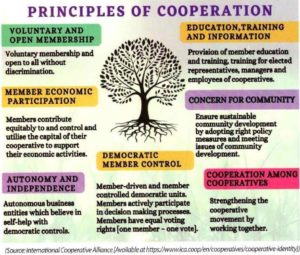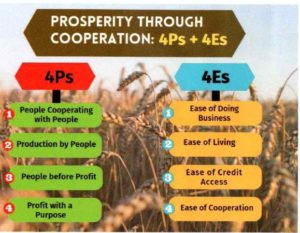ForumIAS announcing GS Foundation Program for UPSC CSE 2025-26 from 19 April. Click Here for more information.
Contents
- 1 Introduction
- 2 What is the significance of cooperatives?
- 3 Brief history of cooperatives
- 4 What are the cooperative principles?
- 5 Commitment to cooperative movement
- 6 How model bye-laws will make PACS vibrant?
- 7 What are the other measures for PACS?
- 8 Developing National Database
- 9 What should be done to consolidate cooperative credit?
- 10 What steps are being taken for improving cooperative education and training?
- 11 What should be the future course of action?
| For 7 PM Editorial Archives click HERE → |
Introduction
For harnessing cooperation for prosperity and progress, Prime Minister Narendra Modi established the Ministry of Cooperation (MoC) as a separate administrative body in July 2021, with a call for “Sahakar se Samriddhi” (prosperity through cooperation). The ministry adopts a Whole-of-Government approach to effectively implement government initiatives. During the Amrit Kaal (2023-2047), India has the opportunity to emerge as one of the world’s economic leaders by harnessing the power of cooperation.
What is the significance of cooperatives?
Cooperation, represented by the term “Sahakarya” means working together and signifies team trusteeship.
By adopting a cooperation-led economic model, India can foster balanced regional development and inspire local entrepreneurs to have a global perspective.
Cooperation serves as a powerful tool to attain economic freedom, self-reliance, and social justice.
Cooperatives, as community-level business organizations, have the potential to generate and absorb social capital.
Brief history of cooperatives
Throughout India’s history, cooperation has been deeply rooted in its way of life, reflecting the core principle of Vasudhaiva Kutumbakam, which emphasizes the concept of the world as one family.
The cooperative movement in India initially emerged as a relief-oriented effort with the promulgation of the Cooperative Credit Societies Act in 1904, later amended in 1912. Its primary focus was on mobilizing rural credit and providing financial assistance to farmers.
However, with the recommendations by the Maclagan Committee on Cooperation in India (1914-15), the cooperative movement transformed from a relief-oriented approach to a more comprehensive agenda of enhancing socio-economic welfare.
In post-independent India, cooperatives were acknowledged as essential contributors to the country’s development and progress and were duly included in the perspective plans of the Government of India.
Today, India is home to 8.54 lakh cooperatives of which 80% are non-credit cooperatives, and 20% are credit cooperatives. Today, cooperatives have a presence in 98% of villages, with 29 crore members.
What are the cooperative principles?
Cooperatives are people-centric organizations as they operate with a focus on people rather than capital. They promote collective cohesiveness, community business sense, and stronger social bonds by adhering to the seven golden principles of cooperation.

Cooperation holds immense potential to ensure comprehensive economic growth. For example, Sardar Vallabh Bhai Patel, through Tribhuvandas Patel, sowed the seeds of Anand Milk Union Limited (Amul). It has now become a global diary brand.
Cooperatives’ full potential as a business model for achieving inclusive development is yet to be fully harnessed. Addressing hurdles and challenges through appropriate policies and effective government interventions is necessary to unleash the complete potential of cooperatives. This can be done through 4 Ps and 4 Es framework for attaining Sahakar se Samriddhi.

Commitment to cooperative movement
The government has decided to plan, prioritise and explore new emerging areas for cooperatives through the ‘SQUAD’ framework:
S – Self-reliance (Atmanirbhar)
Q – Quality Performance
U – Unshakable Cooperative Movement
A – Accountability in Governance
D – Development through Modern Technology
To establish a uniform legal and operational framework for cooperative development, the Union Government collaborating with the States/UTs. To achieve this, the government is formulating an all-inclusive National Cooperation Policy through a committee (Chairman: Suresh Prabhu).
How model bye-laws will make PACS vibrant?
Model bye-laws for Primary Agricultural Credit Societies (PACS) have been formulated and shared with the States/UTs for their consideration and adoption.
These model bye-laws aim to establish a dynamic and robust cooperative culture at the grassroots level, fostering the development of multi-purpose and multi-dimensional cooperatives.
So far, 22 States/UTs have adopted the model bye-laws. The model byelaws have the potential to enhance operational efficiency, transparency, and responsibility towards collective community development.
What are the other measures for PACS?
PACS and Large Area Multi-Purpose Societies (LAMPS) will provide more than 300 e-services to citizens as common service centers (CSC).
PACS will be integrated with Farmer Producer Organisations (FPOs) under the existing FPOs Scheme of the Ministry of Agriculture and Farmers Welfare. This would help PACS extend their scope of activities.
The PACS are now eligible to avail licenses for Petrol/ Diesel dealerships and LPG distributorships.
Developing National Database
MoC is developing a cooperative database which will store authentic and updated data on cooperatives of all sectors.
It will help stakeholders carry out data analytics, find gaps and support policy formulation.
What should be done to consolidate cooperative credit?
To strengthen the Long-Term (LT) cooperative credit structure, MoC is working on a project for the computerisation of Agricultural and Rural Development Banks (ARDBs).
Computerisation of PCARDBs and State Cooperative Agriculture and Rural Development Banks (SCARDBs) will remove issues, inadequacies, and inefficiencies in their operation and profitability.
What steps are being taken for improving cooperative education and training?
The government is creating a national cooperative university for a comprehensive, integrated and standardised structure for cooperative teaching and training.
The university will also meet the demand for capacity building of the existing workforce while ensuring a local, adequate, and quality supply of trained workforce.
What should be the future course of action?
To realise the potential of cooperatives, primary cooperatives at the community-level must be empowered and revitalized as a priority.
Some issues require immediate attention. They are – (a) reduction in regional and sectoral imbalances in cooperative spread; (b) meeting regulatory complexities; (C) improving governance, leadership and operational systems; (d) ensuring professional management; (e) initiating structural reform measures, etc.
There should be collective efforts to ensure a uniform and quick spread of cooperatives across States/UTs.
The vision of Sahakar se Samriddhi will be realised in its true sense if cooperatives adhere to the core philosophy of the cooperative-based model of socio-economic progress.




